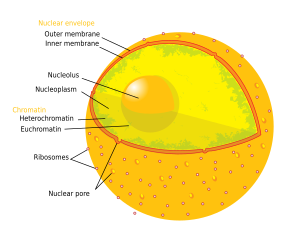Nucleoplasm
The existence of the nucleus, including the nucleoplasm, was first documented as early as 1682 by the Dutch microscopist Leeuwenhoek and was later described and drawn by Franz Bauer.
[5] However, the cell nucleus was not named and described in detail until Robert Brown's presentation to the Linnean Society in 1831.
[6] The nucleoplasm, while described by Bauer and Brown, was not specifically isolated as a separate entity until its naming in 1882 by Polish-German scientist Eduard Strasburger, one of the most famous botanists of the 19th century, and the first person to discover mitosis in plants.
[8] Some nucleoporins which typically make up the nuclear pore, can be mobile and participate in the regulation of gene expression in the nucleoplasm.
[9] The nuclear matrix is also believed to be contained in the nucleoplasm where it functions to maintain the size and shape of the nucleus, in a role similar to that of the cytoskeleton found in the cytoplasm.
The nucleoplasm is a highly viscous liquid that is enveloped by the nuclear membrane and consists mainly of water, proteins, dissolved ions, and a variety of other substances including nucleic acids and minerals.
Additionally, the nucleoplasm is host to many of the enzymes that play essential roles in cellular metabolism.
[15] Importantly, the nucleoplasm contains co-factors and co-enzymes, including acetyl-CoA, which plays a vital role in the citric acid cycle,[16] and ATP, which is involved in energy storage and transfer.
Their ionic compositions are nearly identical due to the ion pumps and permeability of the nuclear envelope, however, the proteins in these two fluids differ greatly.
The cytoplasm contains the cytoskeleton, a network of protein filaments found in all cells, while the nucleoplasm is believed to contain the nuclear matrix, a hypothetically analogous network of filaments that organizes the organelles and genetic information within the nucleus.


